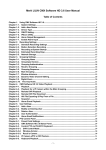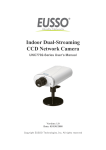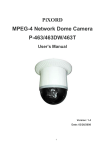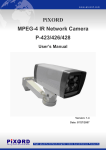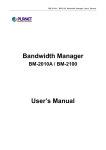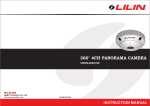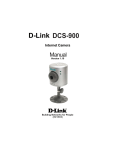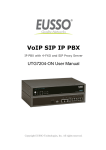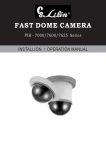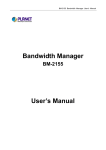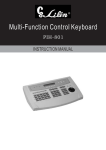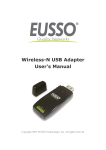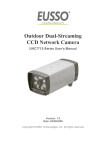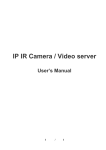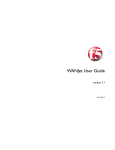Download User Manual - EUSSO Technologies, Inc.
Transcript
Outdoor 35X Dual-Codec CCD IP Speed Dome Camera UNC7835-O User’s Manual Copyright EUSSO Technologies, Inc. All rights Reserve 1 Content 1. Preface.......................................................................... 6 2. Features ........................................................................ 7 3. Warning & Cautions ...................................................... 8 4. Structure Element........................................................ 10 5. Fast Dome Camera Set Up..........................................11 5. 1 RS-485 Protocol Switch Setting ................................................................11 5. 2 RS-485 Communication Mode Selection.................................................12 5.3 Transmission Speed Setting .......................................................................12 5.4 Protocol Setting.............................................................................................12 5. 5 RS-485 Protocol DIP Switch for UNC7835-O Setting ...........................12 5.6 Fast Dome ID Address Setting Refer Chart .............................................13 6. Installation ................................................................... 16 7. System Configuration.................................................. 19 7.1 Fast Dome and Keyboard ...........................................................................19 7.2 Fast Dome, Matrix and Keyboard ..............................................................21 7.3 Fast Dome with PC Control ........................................................................22 7.4 Fast Dome, DVR and Keyboard.................................................................23 8. Software Installation.................................................... 24 9. Network Configuration................................................. 25 9.1 Preparation before IP Assignment .............................................................25 9.2 Using IP Installer...........................................................................................25 10. Usage of Web-based User Interface......................... 28 10.1 Browse Live Video......................................................................................28 Menu Language Selection...................................................................28 10.2 Video Channel Selection ...........................................................................29 10.3 Pan / Tilt / Zoom Control ...........................................................................29 2 10.4 Digital Zoom Selection...............................................................................30 10.5 Rotate the Video .........................................................................................30 Select the Channel..............................................................................30 Rotate the Video..................................................................................30 10.6 Video Recording .........................................................................................31 11. Configuration of Web-Based User Interface.............. 32 11.1 Configuration Preview................................................................................32 A/V Settings ........................................................................................32 Network Settings .................................................................................32 System ................................................................................................33 Event ...................................................................................................33 Others .................................................................................................33 11.2 Configuration of A/V Setting......................................................................34 Basic A/V Settings...............................................................................34 Advanced A/V Settings........................................................................36 Image Adjustment ...............................................................................37 11.3 Setting External Sources...........................................................................38 11.4 PTZ Settings................................................................................................39 Setting the ID for Network Dome Camera ...........................................39 Operating the Dome Camera ..............................................................40 Preset Point Setting ............................................................................41 Setting Preset Point ............................................................................41 11.5 Setting Day / Night Mode ..........................................................................43 11.6 Changing the Lens Speed between Default and Manual Setting .......43 11.7 On Screen Display......................................................................................44 11.8 Configuration of Network Setting .............................................................45 General Settings .................................................................................45 Dynamic DNS Settings........................................................................46 11.9 Configuration of System ............................................................................50 System Information .............................................................................50 Time Configuration ..............................................................................51 User Settings.......................................................................................52 11.10 Firmware Upgrade ...................................................................................53 11.11 Configuration of Event .............................................................................54 General ...............................................................................................54 Set Motion Area...................................................................................55 Set Email and FTP ..............................................................................56 3 12. Operation .................................................................. 57 12.1 Initial Power Up Inspection .......................................................................57 12.2 Manual Operation (Pan/Tilt Control)........................................................57 12.3 Fast Dome Selection..................................................................................58 12.4 Zoom Lens Control.....................................................................................58 12.5 Focus Control..............................................................................................58 12.6 Iris Control ...................................................................................................59 12.7 Horizontal 180° Instant Flip.......................................................................59 12.8 Preset Position Setting ..............................................................................59 12.9 Recalling Preset Positions ........................................................................61 12.10 Setting Preset Group ...............................................................................61 12.11 Changing Preset Data .............................................................................62 12.12 Activating Auto Pan ..................................................................................62 12.13 Deleting Preset Data................................................................................62 12.14 Alarm Management..................................................................................63 12.15 Alarm Output .............................................................................................64 13. Setup Menu Tree....................................................... 65 14. Fast Dome Camera Function Setup.......................... 67 14.1 Setup Menu Display...................................................................................67 14.2 Language Selection ...................................................................................67 14.3 Display Setup ..............................................................................................68 14.4 Dome Setting ..............................................................................................71 14.5 Camera Setting...........................................................................................71 14.6 Pan/Tilt Setting Menu.................................................................................77 14.7 Preset Function Setting Menu ..................................................................81 14.8 Tour Function Setting Menu......................................................................84 14.9 Privacy Zones Setting Menu.....................................................................86 14.10 Alarm Setting Menu .................................................................................87 14.11 Password Function Menu........................................................................88 14.12 Restore Factory Defaults ........................................................................90 14.13 Schedule Setup Menu .............................................................................92 14.14 Alarm Input Schedule Setting Menu......................................................92 14.15 Start Auto Options Menu .........................................................................93 14.16 Daylight Saving Time Menu....................................................................95 14.17 Display System Information....................................................................96 4 14.18 Camera Reset...........................................................................................97 15. Specification .............................................................. 98 15.1 Operational ..................................................................................................98 15.2 Camera ........................................................................................................98 15.3 Optical Lens ................................................................................................99 15.4 Electrical ......................................................................................................99 15.5 Environmental .............................................................................................99 15.6 Mechanical ..................................................................................................99 Appendix A .................................................................... 100 Quick Reference Table .....................................................................................100 Appendix B.................................................................... 101 Trouble Shooting ...............................................................................................101 Appendix C.................................................................... 102 Preset ID Characters Table..............................................................................102 5 1. Preface UNC7835-O is an outdoor fast dome cameras with high resolution of 520 TV lines offer significant enhancement and refinements to bring you the most innovative surveillance solutions. UNC7835-O is the leading product in the industry offering the most advanced features such as 35X optical zoom lens, auto white balance mode selection, IR cut filter function, auto focus control, auto iris control etc. UNC7835-O measure only 210mm in diameter and is capable of making 360 degrees continuous rotation with a speed range of 0.15 to 360 degrees per second, ensures direct and accurate target positioning. When required the dome can be quickly spun through 180 degrees, an important feature when something passes directly under the camera. Up to 128 preset positions can be programmed and recalled with an accuracy of 0.25 degrees. First 16 presets can be divided into 4 groups for auto touring with individual setting for speed and dwell time. UNC7835-O has 6 alarm inputs (expandable to 64) can drive the dome to any position in under second. A local alarm output can be configured as NO or NC and two types of alarm response mode provide flexible alarm management. RS-485 control interface makes our fast dome cameras easy to fit into out existing systems and compatible with other manufactures’ control systems. UNC7835-O is fully functional and user-friendly. It will meet your need for a wide range of surveillance application. 6 2. Features z 35X Auto Focus Lens: Build-in 35X optical zoom lens with focal length 3.6~126mm z 520 Horizontal TV lines z Automatic / Manual Iris Control z Preset ID / Name z Preset Background Environment File z Private Mask z 360 degrees continuous rotation z Up to 128 programmable preset positions z Preset positions auto scanning z High speed rotation and tilt, speed range varies from 0.15∘/ sec ~ 360∘/ sec z 180 degrees Horizontal Instant Flip z 6alarm inputs, 1 alarm output can be set as NO (normally open) or NC (normally close) for each fast dome z Two types of alarm response mode: Lock Mode and Release Mode z Build-in 1/4” CCD high resolution DSP color camera: 1. Color / Mono Switch (IR Cut Filter) In -> Color Out -> Mono Auto -> Switch from color to mono when light drops below 3 lux Schedule -> Switch from color to mono by time of setup 2. 520 TV lines (color); 580 TV lines (Mono) 3. 0.1 Lux (Color); 0.01 Lux (Mono) 4. On-Screen Setup Menu 5. White Balance Control: Auto Correction, Manual 6. Back Light Compensation: On/Off 7. Auto Gain Control: 0db~36db 8. 8 levels Brightness Adjustment 9. 16 levels Pedestal Adjustment 10. Aperture Correction Adjustment 11. Flickerless: On/Off z RS-485 control interface z Up to 256 fast dome configuration z Compatible with PC Control (protocol required) z Flexible Mounting: Outdoor type z Power supply options: 100~240VAC or 24VAC 7 3. Warning & Cautions Please read the manual before attempting installation or operation 1. Please be aware to the warnings and cautions notice. 2. Don’t use any chemical detergent to clean the machine surfaces, use a damp cotton cloth only. Regularly clean the dome cover to assure proper focus ability. Please install the fast dome in a dry area, water and high humidity may cause damage internal parts. External housing should be used for outdoor installation. 3. Please use parts supplied by the manufacturer only, any unqualified part used in the equipment may violet the warranty. 4. Avoid installing the equipment in an unstable area. Make sure the area is firm and stable. Falling equipment may injure personnel and damage the equipment. 5. Do not install the equipment near any flammable gas. Violation may cause fire or injury. 6. Avoid running video cable and signal cable through or passing interference sources such as video waves, broadcast station, power generator, elevator motor or high voltage area etc. Violation may cause interference. 7. Make sure the power cable is properly fixed. Un-suitably fixed cable may cause serious short circuit or fire. 8. Correct cable connection is important. Do not place any object on the connection cable and change the cable if there is damage on cable. Violation may cause short circuit, fire and injury. 9. Make sure ground is well connected to avoid damage caused by lightning. 10. Do not put any foreign objects inside the equipment and do not spray any liquid on equipment. This will avoid short circuit damage. 11. Do not touch power connection with wet hands to avoid short circuit or electricity shock. 12. Do not apply smash- force on the equipment. Violation may cause damage. 13. Do not install the equipment in a location that may expose the equipment to sunlight. Violation may cause color fading or damage. 14. Do not install the equipment in high temperature or low temperature environment to avoid damage. The normal operational temperature is between -10℃~ +50℃. 15. fast dome contains high sensitive electric parts inside. Do not try to repair them without qualifies personnel. 16. Turn off the power immediately and contact the technician when the following occurs: Damage on power cable or plug Water leaks into the equipment Fast dome can not be operated normally Equipment falling on ground or damage on external cause 8 Unusual occurrence 17. Warning: Do not try to repair the equipment. Only a qualified technician may disassemble and repair the equipment. Shut off the power before disassemble the equipment and don’t put power on unless the case is completely assembled. 9 4. Structure Element 1. 2. 3. 4. 5. 6. 7. 8. Dome Cover Camera Case Upper Base Power In Jack (AC100~240V) RJ45 (network cable) RS-485 In/Out Terminal Video Out Jack Alarm In/Out connector 10 5. Fast Dome Camera Set Up 5. 1 RS-485 Protocol Switch Setting Explanation of DIP Switch Setting: 1. RS-485 In-TML RES : RS-485 IN Terminal Resistor ON/OFF 2. RS-485 OUT-TML RES : RS-485 OUT Terminal Resistor ON/OFF 3. HALF/FULL :2 wiring system (HALF duplex) or 4 wiring system (Full duplex) 4. BAUD SEL 1 :Transmission speed selection 1 5. BAUD SEL 2 :Transmission speed selection 2 6. PROTOCOL SEL 1 :Protocol selection 1 7. PROTOCOL SEL 2 : Protocol selection 2 8. PROTOCOL SEL 3 : Protocol selection 3 9. PROTOCOL SEL 4 : Protocol selection 4 10. - :NA (Using Pelco D, please contact your nearest agent) RS-485 In/Out Terminal Resistor Setting Daisy Connection: Set RS-485 In and Out terminal resistor as ON (Factory Initialize) Parallel Connection: Set the front and last equipment terminal resistor as ON. The parallel connection equipment in the middle set as OFF to keep the best transmitted statues. 11 5. 2 RS-485 Communication Mode Selection DIP SWITCH 3 2 wiring system (HALF duplex) OFF 4 wiring system (FULL duplex) ON Communication Mode of HALF: Most of systems use this mode because of low-cost and easy setup, but this mode can’t receive and transmit data simultaneously. Communication Mode of FULL: This Mode can receive and transmit data simultaneously. 5.3 Transmission Speed Setting BAUD RATE SELECTION DIP SWITCH 4 5 2400 bps ON ON 4800bps OFF ON 9600 bps ON OFF 19200 bps OFF OFF Remark: EUSSO Protocol use Baud Rate 9600bps. 5.4 Protocol Setting PROTOCOL SELECTION DIP SWITCH MLP 1 VERSION 6 7 8 9 OFF ON ON ON 5. 5 RS-485 Protocol DIP Switch for UNC7835-O Setting RS-485 PROTOCOL DIP SWITCH SETTING DIP 1 2 3 4 5 6 7 8 9 10 ON ON OFF ON OFF OFF ON ON ON OFF SWITCH MLP 1 VERSION 12 5.6 Fast Dome ID Address Setting Refer Chart Up to 64 fast dome cameras can be serial linking in one system. Therefore each dome is addressing by ID switch located at the base of the fast dome. When select MLP 1, camera ID setting as followings: 13 Fast Dome Connection Jack and Cable Requirement 1. AC 100~240V Power Cable 2. AC 24V Power Cable Recommend Cable: Accessory Connector Information Assemble the Cable with the Accessory Connector A. Strip back the cable jacket approx. 3mm and separate the individual conductors. 14 B. Prepare the individual conductors for clamping. After clamping the contacts, push them into the proper holes in the accessory connector of this camera until they snap in place. CAUTIONS: CONNECT THIS TO 24V AC CLASS 2 POWER SUPPLY ONLY 3. RS-485 In/Out Terminal RS-485 Input (TXDO+, TXDO-) to receive signal from keyboard, matrix, DVR or multiplexer through twisted pair cable. RS-485 Output (TXDO+, TXDO-) sending out signal to next fast dome through twisted pair cable. Transmission Distance: Max. 1 kilometer 4. Video Out BNC Jack Video Signal Output CVBS 1.0V p-p 75ΩBNC Recommend Data Cable: 5C2V 5. Alarm In/Out Connector Each fast dome contains 6 alarm inputs and 1 alarm output Alarm Input Voltage: 5.6V max. Alarm Output: 1A 24VDC Recommend Data Cable: UL26AWG 80℃ 300V UL24AWG 80℃ 300V 15 6. Installation Step 2 Step 1 Separate bracket from base of bracket Step 2 Fix base of bracket on the wall Step 3 Attach camera to bracket 16 Step 4 Fast Dome Camera Setting Step 5 Connect Jack 17 Step 6 Fix bracket and outdoor fast dome camera with base 18 7. System Configuration UNC7835-O is suitable for a wide range of surveillance applications. The system can be single fast dome with one keyboard or encompassing as 64 domes with comprehensive matrix switching, PC control and even Digital Video Recording. Such flexibility means future expansion is easily facilitated. 7.1 Fast Dome and Keyboard Single dome configuration: One fast dome camera connects to one PIH-800II or PIH-931D/932T. Telemetry control is sent via twisted pair between Dome and Keyboard. Video signal from the dome is sent to monitor or multiplexer or quad or switcher. RS-485 Connection st 1 pin TXDI+ of RS-485 jack at back of the keyboard connects to TXDI+ of RS-485 jack on fast dome. 2nd pin TXDI- of RS-485 jack at back of the keyboard connects to TXDI- of RS-485 jack on fast dome. 19 Multiple Domes means that more than one fast dome is linked in the system. Each dome connects to next dome forming a serial linking. Each dome has an individual ID dip switch, which allows the keyboard to identify each fast dome and make command. Sometimes it is more convenient to wire a telemetry system in star configuration rather than daisy chain. To do this a PIH III data distributor is necessary. It takes an output from a keyboard or a matrix and splits the single data line into 4 separate data lines. One keyboard can control up to 64 cameras. RS-485 Connection Between PIH-804III Data Distributor and fast dome 1st output TXDI1+ of PIH-804III connects to TXDI+ of 1st fast dome and TXDI1- of PIH-804III to TXDI- of 1st fast dome. Linking 2nd Fast Dome TXDO+ of 1st fast dome connects to TXDI+ of 2nd dome and TXDO- of 1st dome to TXDI- of 2nd dome. RS-485 Connection Between PIH-804III Data Distributor and keyboard 1st pin TXDI+ on RS-485 IN jack of keyboard connects to TXDO+ on RS-485 OUT jack of PIH-804III 2nd pin TXDI- on RS-485 IN jack of keyboard connects to TXDO- on RS-485 OUT jack of PIH-804III. 20 7.2 Fast Dome, Matrix and Keyboard Matrix system is designed to process multiple video system and video switching. Its central process unit (CPU) can manage multiple video signals simultaneously and control other linking system, such as fast dome or PIH-820III telemetry receiver. All telemetry remote control and signal transmissions are through twisted pair. One matrix can manage up to 64 fast domes. Multiple keyboards can be used for matrix control. 1st keyboard is the master and the rests are slaves. Up to 8 keyboards can be sued in one system. Each keyboard has a Dip Switch for ID setting. (Please refer to keyboard’s manual for detail) RS-485 Connection Between Matrix and Fast Dome TXD+ of receiver jack on matrix connects to TXDI+ of 1st fast dome and TXD- of matrix to TXDI- of 1st fast dome. Linking 2nd Fast Dome TXDO+ of 1st dome connects to TXDI+ of 2nd dome and TXDO- of 1st dome to TXDDI- of 2nd dome. 64 fast domes can be linked through the connection as shown. RS-485 Connection Between Keyboards TXDO+ of 1st keyboard RS-485 OUT connects to TXDI+ of 2nd keyboard RS-485 IN TXDO- of 1st keyboard RS-485 OUT connects to TXDI- of 2nd keyboard RS-485 IN 21 RS-485 Connection Between Keyboard and Matrix TXDI+ of 1st keyboard RS-485 IN connects to 1st pin TXD+ of matrix’s keyboard jack. TXDI- of 1st keyboard RS-485 IN connects to 2nd pin TXD- of matrix’s keyboard jack. 7.3 Fast Dome with PC Control PC telemetry remote controls fast dome with standard RS-485 data format (Baud Rate 9600bps). The PC control port RS-232 is converted to RS-485 format by interface. User may use their own software (protocol). In this system up to 64 fast domes can be linked. 22 RS-485 Connection Between Fast Dome and Conversion Interface TXD+ of conversion interface RS-485 jack connects to TXDI+ of 1st fast dome and connect TXD- to TXDILinking 2nd Fast Dome TXDO+ of 1st dome RS-485 jack connects to TXDI+ of 2nd dome to TXDO- of 1st dome to TXDI- of 2nd dome. 64 fast domes can link through the connection as shown. 7.4 Fast Dome, DVR and Keyboard The DVR System is an advanced digital recording product, with long recording time and easy searching features. Telemetry remote control is twisted pair for data transmission to the fast dome. Fast dome can be controlled directly from the control panel of the DVR or from keyboard. Each DVR (Digital Video Recorder) can manage 16 video signals and via RS-485 to daisy connection 16 sets of fast dome camera. RS-485 Connection Between Fast Dome and DVR TXD+ of DVR RS-485 jack connects to TXDI+ of 1st fast dome and TXD- of DVR to TXDI- of the 1st fast dome. Linking 2nd Fast Dome TXDO+ of 1st dome RS-485 jack connects to TXDI+ of 2nd dome to TXDO- of 1st dome to TXDI- of 2nd dome. RJ-45 Connection Between DVRs st nd “Keyboard Out” of 1 DVR pass out RJ-45 jack connects to “Keyboard In” of 2 DVR’s RJ-45 jack. RJ-45 Connection Between DVR and Keyboard “Keyboard In” of 1st DVR’s RJ-45 jack connects to RJ-45 jack of keyboard. 23 8. Software Installation With the exception of the Macromedia Flash Player all the software that is necessary for the proper display and use of the device is available on the included CD or from the website. For the following installation procedures it is assumed that all installation media will be taken from the CD. IP Installer The IP Installer is used to locate and configure network cameras and video servers on the LAN. This utility is useful for conveniently configuring the network settings of the NDC, or for finding a device once the network settings have been modified. To install the IP Installer, from the installation CD UI, select IP installer, then follow the on screen instructions. Component Installer This will install all ActiveX components used by our devices for video display and device configuration. Adobe Flash Player Please visit the Macromedia Web site at http://www.adobe.com/downloads/ to download and install the Flash Player. 24 9. Network Configuration IP Installer is a utility that provides an easier, more efficient way to configure the IP address and network settings of the camera. It even provides a convenient way to set the network settings for multiple devices simultaneously using the batch setting function. Moreover, IP Installer can save the network settings for all devices as a backup and restore them when necessary. 9.1 Preparation before IP Assignment Always consult your network administrator before assigning an IP address to your server in order to avoid using a previously assigned IP address. Ensure the camera is powered on and correctly connected to the network. MAC Address: Each camera has a unique Ethernet address (MAC address) shown on the bottom of the camera as the serial number (S/N) with 12 digits (e.g. 000429-XXXXXX). One final note, although the IP Installer is able to find and configure any camera on the LAN except those that are behind a router, it is a good idea to set the host PC to the same subnet. In order to connect to the Web-based user interface of the camera, the host PC must be in the same subnet. For more information about subnets, please consult your network administrator. 9.2 Using IP Installer Assigning IP address to Camera Once IP Installer has been successfully installed on the computer, double click the IP Installer icon on the desktop, or select it from Start > Programs > IP Installer. The IP Installer window is displayed below. Click the menu bar Tool > Search Network Device to search the camera in the LAN. 25 From the list, select the device with the MAC Address that corresponds to the device that is to be configured. The MAC Address is identical to the unit’s S/N (Serial Number). Double click the item to open the Property Page dialog box for the selected device or click the menu bar View > Property. After filling in the properties, click [Synchronize] button to complete the configuration settings in the remote camera while saving configuration in the PC. If click [OK] button, the configuration is only saved in the PC. 26 Open the Web-based UI of the Selected camera To access the Web-based UI of the selected unit, run the View > Open Web on IP installer menu bar. If the device has been configured correctly, the default Web browser will open to the home page of the selected device. If you find your browser is opened and automatically connected to the camera Home Page, it means you’ve assigned an IP Address to the unit successfully. Now you can close the IP Installer and start using your camera. Verify and Complete the Installation from Your Browser Start your browser and enter the IP Address of your NDC in the Address field. When browsing the Home Page at the first time with the Microsoft Internet ExplorerTM, you must temporarily lower your security settings to perform a one-time-only installation of the ActiveX component onto your workstation, as described below. 1. From the Tools menu, select [Internet Options] 2. Click the [Security] tab and then click [Custom Level] button to see your current security settings. 3. Set the security level to Low and click [OK]. 4. Type the URL or IP address of your camera into the Address field. 5. A dialog box will pop up asking if the ActiveX control should be installed. Click [Yes] to start the installation. 6. Once the ActiveX installation is complete, return the security settings to their original value, as noted above. 27 10. Usage of Web-based User Interface Start your Web browser and enter the IP Address of your Camera in the Address field. The Home page of the camera is now displayed. The Web UI can present up to 4 video source indicating 4 video channels. Each channel can be shown individually or in one of 4 split windows. Full Screen The status of the video stream Video stream from camera (Local video source) Maximizes to view the selected channels into full 1 2 3 4 External video 10.1 Browse Live Video Menu Language Selection The online Web-based User Interface can allow the user to select 3 different languages: English, Traditional and Simplified Chinese. Such display will not affect the original configuration for the language, allowing multiple users to have different languages concurrent views. In order to make the language change permanent, settings must be modified through the Configuration 28 page, and saved once it is made. 10.2 Video Channel Selection The Video Channel allows the users to choose viewing 1 channel at a time or 4 channels at the same time. CH1 displays the video stream of the camera. CH2~4 display the video stream of the IP Camera or Video Server that connected the device via network. Select “All” to display the local video stream (Channel 1) as well as 3 external video sources (Channel 2 ~4). Select 1~4 to display the video stream of single channel. Select Actual to display the video stream at the actual resolution 10.3 Pan / Tilt / Zoom Control The PTZ control panel allows the users to pan, tilt and zoom the dome. Speed: Click on the arrow button and select the speed of the Pan and Tilt movements. Values run from 1 to 7. Being 1 the slowest and 7 the fastest. Preset Point: Click on the arrow button and select the preset point from the pull-down list for quick view. Manual Pan/Tilt: Click on the 8-directions button to move the camera to that direction. Click on the rectangle button to stop the movement. 180o button: The viewing will turn 180 degrees. Zoom -: Click on this button for Zooming Out. Zoom +: Click on this button for Zooming In. Iris +: Opens the iris and brightens the picture. Iris -: Opens the iris and reduces glare. Focus +: The target will become nearer. Focus -: The target will become farther. Auto Iris: The lens will automatically adjust itself for optimum iris. Auto Focus: The lens will automatically adjust itself for optimum focus. Auto Pan: Click on the arrow button to activate; click on the rectangle button to stop. When the Auto Pan function is activated, the camera will auto touring the preset groups entered. Only the first 16 preset points of the camera can be set to auto pan mode and first 6 preset points are 29 corresponding with the 6 alarm. To pan/tilt/zoom the external video sources CH2~CH4, click on [CH2~4 PTZ Control] button to open a new window. Select the channel in this window to display the PTZ control panel for operation. 10.4 Digital Zoom Selection The Digital Zoom enable user to select the digital size for the channels. Select [x1], [x4] or [x9] to enlarge the video. Select [Draw Mode] and then use mouse to select an area on the video for enlargement. 10.5 Rotate the Video The [Video Status] item allows the users to see the current settings of the selected channel. It also includes the function for video rotation and record the video for the selected channel. Select the Channel Click on the number tab, and status for the selected channel will be displayed. The settings can be setup in Configuration page Rotate the Video Click on [Rotation] button to temporary rotate the selected video 90 degrees clockwise direction. This feature is to have natural view for cameras that are hooked up on walls and/or vertical positions. 30 10.6 Video Recording Before recording the selected channel, you can check the information of recorded file by clicking on [Recording Information] item. To record the video for each channel: 1. Click the channel number on the tab under [Video Status]. 2. Click on [Manual Recording] button, it will start recording live video of the selected channel. A “REC” message will display on the video. 3. The device can record multiple channels at the same time. To record other channels, just repeat step 1 and 2. 4. To stop recording, select the channel from the tab and then click [Manual Recording] button again, the “REC” message will disappear and the recording is stopped. By default, the recorded file will be saved in a folder named C:\Recfile\pppp\CHx\ ♦ pppp : The model number of the device ♦ x : The number of the recorded channel The default filename will be named under Locals_Recyyyymmdd-hhmmss.avi ♦ yyyy : Current Year ♦ mm : Current Month ♦ dd : Current Date ♦ hh : Current Hour ♦ mm : Current Minute ♦ ss : Current second The file will be saved as an AVI file, which can be play back with most media players. The video is always recording with the actual direction. It will not be affected by the rotation of viewing. 31 11. Configuration of Web-Based User Interface The Configurations of the cameras are presented as links in the margin of the Configuration Page. Simply click the relevant link for the settings you want to configure. 11.1 Configuration Preview A/V Settings Functions Description General Set the parameters of video and adjust the image of the device. External Sources Set the video source for channel 2 to 4, using digital inputs (IP Address). PTZ Settings To control the PTZ device and set the preset points. On Screen Display Set the text and location to display on the video. Network Settings Functions Description General Assign an IP Address and configure the relevant network parameters to the device. DDNS The DDNS (Dynamic Domain Name Service) is used to access the camera with an easy memorized name such as http://demo.ddns.com instead of http://192.168.0.200. 32 System Functions Description System Information Set various information about the name of the device and the language type, etc. Time Configuration Set the Date and Time. User Add and delete users and passwords. Firmware Upgrade Browse firmware location to upgrading Event Functions Description General Enable/disable the event trigger and select the action when triggered. Motion Area Set the area on video for motion detection. Email / FTP Input the Email and FTP address to receive alert message or snapshot, sent by event trigger. Others Functions Description Live Returns to the Live Video display. Reboot Close the Web browser and reboots the device. 33 11.2 Configuration of A/V Setting Basic A/V Settings Resolution There are 3 different resolutions to choose from: ♦ D1: 720x480 NTSC / 720x576 PAL (DVD Standard resolution) ♦ SIF: 352x240 NTSC / 352x288 PAL ♦ QSIF: 176x120 NTSC / 176x144 PAL Frame Rate: The frame rate can be set between 5 to 30 FPS. Encoder Format ♦ MPEG4 constant bitrates: Select MPEG4 and CBR. ♦ MPEG4 variable bitrates: Select MPEG4 and VBR ♦ Motion JPEG. Bitrate For Motion JPEG format, there are 4 variable bitrates between Low and High quality. For MPEG4 format, there are 12 different constant bitrates to choose from 64Kbps to 4Mbps, and 4 variable bitrates between Low and High quality. 34 If you are planning on using the device on an Internet connection, it is recommended that you select a constant bitrate that corresponds to your actual upload speed. It is also recommended that you modify the frame rate and resolution as well, otherwise the video stream may become blocky or otherwise distorted. The recommended settings for low-speed network connection are as follows: ♦ 64Kbps: ♦ 128Kbps: recommended settings are [QSIF, FPS<15] ♦ 256Kbps: recommended settings are [SIF, FPS<10] ♦ 512Kbps: recommended settings are [SIF, FPS<15] ♦ 768Kbps: recommended settings are [Full D1, FPS<10] ♦ 1Mbps: recommended settings are [QSIF, FPS<10] recommended settings are [Full D1, FPS<15] For higher frame rate use a variable bitrate instead. However, this is not recommended for Internet use ♦ Average Quality is recommended if the VBR is selected. ♦ For Good Quality, full resolution (D1) and full frame rate (30/25 fps) it is recommended that not more than 4 users connect simultaneously. ♦ For High Quality, full resolution (D1) and full frame rate (30/25 fps) it is recommended that no more than 2 users connect simultaneously. Auto adjust the frame rate under high traffic: After enable this option, the frame rate will be automatic adjusted to Apply: Click this button to save the changes made. 35 Advanced A/V Settings Interlacing There are 2 modes available: Interlaced or Progressive. Interlaced mode is a storage mode. An interlaced video stream contains fields rather than frames, with each field containing half of the lines of a frame. A progressive video stream consists of only full frames. Interlaced video streams can bring a lower bitrate but may cause lower quality. TV Standard: The TV standard can be set among these 3 formats NTSC, PAL and SECAM. Sequence Mode There are 2 different modes available: ♦ I-frames only ♦ I-frames and P-frames P-frames, or predictive frames, are predicted based on prior P or I-frames plus some additional data. They have a much higher compression ratio than I-frames. I-frame only mode has very little compression resulting in large file sizes. I-frame and P-frame mode offers relatively good compression with medium file sizes. Although this requires more work on the host PC to decode the video. GOP Size: GOP stands for Group Of Pictures. It defines the number of frames from one I-frame to the next. Since an I-frame uses very little compression, while P/B frames use much higher compression, a larger GOP size results in smaller file sizes. Peak Bitrate: This is used to set a maximum bitrate that can be achieved. This is useful for setting bitrates between the values that are available from the Video Encoder bitrate list. Apply: Click this button to save the changes made. 36 Image Adjustment Contrast, Brightness, Hue and Saturation: The value can be adjusted from -100 to 100. Rotation: Rotation degrees run from 0 to 270 degrees for a permanent digital position. ♦ 0: 0 degree ♦ 1: 90 degrees ♦ 2: 180 degrees ♦ 3: 270 degrees Load Default: Click this button to set the image adjustments back to factory default. Save: Click this button to save the changes made. 37 11.3 Setting External Sources Video Select: Select the channel this external source will be displayed. IP Address: Enter a valid IP address from an IP Camera or Video Server. Http Port: Enter the port number used for the IP address for network connection. Video Type: Select MJPEG or MPEG4. The type must match the external source provided. Rotation: Rotation degrees run from 0 to 270 degrees for a permanent digital position. ♦ 0: 0 degree ♦ 1: 90 degrees ♦ 2: 180 degrees ♦ 3: 270 degrees Video Channel: If the external source is a camera connected to a Video Server, select the channel of the Video Server. Username/Password: Enter the respective Username and Password if applicable. If no user has been set for the device, the default value should be root and pass respectively. RTSP Port: Enter a RTSP Port used for streaming in case the external source is a MPEG4 device. PTZ Model: Choose a PTZ model. Name: Enter a name for the device. Product Type: Select from MJPEG or MPEG4 Video Servers or IP Cameras. Please refer to the original document of the device for a better description. Test: Before submitting the information, click on this button to validate the video connection and the live video will be displayed if the settings are correct. Apply: Click on this button to save the changes made. 38 11.4 PTZ Settings Setting ID for NDC Managing Preset Points Select an ID number to match the ID address set by the dome camera. Managing the Preset Points for quick view and auto pan. Changing Lens Speed Switching the lens speed between default setting and manual setting. Setting Day / Night Mode Advanced Function Setup for Camera This pair of buttons is for call out the OSD Setup Menu, and set up more functions. Setting the ID for Network Dome Camera To select an ID number to match the ID address set by the NDC ID switch: 1. Click on the arrow button beside Camera ID and select the number from the pull-down list. 2. Click on [Apply] button to confirm the selection. 39 Operating the Dome Camera To control the dome camera for viewing, follow the description shown on below: Pan / Tilt the Dome Camera To control the pan and tilt movement of the dome camera simply click on the buttons: z To pan or tilt, just click on the 8-directions buttons for the desired direction. z To adjust the speed of the movement, just click on the arrow button beside “Speed” and select the desired speed from the pull-down list. The higher the number selected, the faster the speed. Zoom Lens Control z To zoom in: Click [+] button, the viewing angle becomes narrower and target will become enlarged on the screen. z To zoom out: Click [-] button, the viewing angle becomes wider and target will become smaller on the screen. Iris Control The purpose of iris control is to adjust brightness on target. It can be set as Auto Iris or Manual Iris. z Iris open: Click [+] button, to open the iris and brighten the picture. z Iris close: Click [-] button, to open the iris and reduce glare. z Auto iris: Click the arrow button beside “Auto Iris”, the lens will automatically adjust itself for optimum iris. Focus Control The focus function can be set as Auto Focus or Manual Focus. z Manual focus near: Click [+] button, the target will become farther. z Manual focus far: Click [-] button, the target will become nearer. z Auto focus: Click the arrow button beside “Auto Focus”, the lens will automatically adjust itself for optimum focus. 40 180o Revolve o The viewing angle will turn 180 . Preset Point Setting There are 128 individual preset points. Each preset stores the exact position of the camera and automatic pan, tilt, zoom, focus and iris setting. Once the data is set, the preset can be recalled for viewing, or the presets can be set for auto pan. Note: Only the first 16 preset points of the device can be set to auto pan mode and first 6 preset points are corresponding with the 6 alarm inputs. Selecting Preset Point Click on the arrow button and select the desired number from the pull-down list. Setting Preset Dwell Time Click on the arrow button and select the desired value from the pull-down list. Setting Preset Speed Click on the arrow button and select the desired value from the pull-down list. Save / Remove Preset Data z Click on [Save] button will save the current data as a preset point. z Click on [Remove] button will erase all 128 preset points. Activate / Stop Auto Pan z Activate: Click the arrow button. z Stop: Click the rectangle button. Selecting Preset Group for Auto Pan Select the groups by clicking on the check boxes, then click [Submit] button to save the changes made. Setting Preset Point Select a preset point. (If this point has been set previously, the following procedure will change the previous settings after saving) Move the camera to the desired view position. (Refer to the previous page) Adjust the zoom, focus and iris of lens. When set up preset point, using manual focus will provide both clarity and stability of image. (Refer to the previous page) Set preset Dwell time. The dwell time means the time user wants to view on certain preset point under Auto Pan. The Dwell time can be set between 1 ~ 255 seconds. 41 Set preset speed. The speed the dome travels to that preset point can be adjusted between 10 to 250 seconds. The presets Group 1 ~ 4 (First 16 preset points) can be entered a name for identify. Just fill the text string into the Position Name field. Save the preset point. Once the above steps have been completed, the information must be stored or it will not be memorized by the system. Note: For the first 16 presets on each dome, the above steps must be repeated. For presets 17 ~ 128 there is a default speed and dwell setting so steps 4 and 5 are not required. Setting Preset Group for Auto Pan The purpose of setting preset group allows the management of the 16 preset points before Auto Scanning. The first 16 preset points are separated into 4 groups. Preset group must be set for the auto pan reference. Group 1 includes: 1st, 2nd, 3rd and 4th preset points. Group 2 includes: 5th, 6th, 7th and 8th preset points. Group 3 includes: 9th, 10th, 11th and 12th preset points. Group 4 includes: 13th, 14th, 15th and 16th preset points. To select the groups, click on the check boxes of the groups, then click [Submit] button to save the changes. Activate / Stop Auto Pan When the Auto Pan function is activated, the dome camera will auto touring the preset groups entered. To activate: Click the arrow button. To stop: Click the rectangle button. Deleting Preset Points Sometimes it is necessary to delete the stored preset points. Just click the [Remove] button. Note: All the preset points can be cleared by clicking on [Remove] button 42 11.5 Setting Day / Night Mode There are 3 modes can be selected to set the IR Cut Filter for different environment. Click IR filter Swap to switch the modes. ICR ON (ICR IN): IR Cut Filter is ON and always produces constant color image. ICR OFF (ICR OUT): IR Cut Filter is OFF and always produce monochrome image. ICR AUTO ♦ P463/ P463T: When light drops below 3 Lux, switch from color to monochrome automatically. ♦ P463DW: When light level is over 30 Lux, IR Cut Filter switches IN automatically to produce color image. When light drops below 10 Lux, IR Cut Filter switches OUT automatically to produce monochrome image. Under monochrome mode, sensitivity is increased to 0.01 Lux and can be used with IR illuminators. 11.6 Changing the Lens Speed between Default and Manual Setting Click on Lens Speed to switch the Lens speed between default speed and the manually setup speed. 43 11.7 On Screen Display On Screen Display: Select Enable/Disable for displaying the text over the video. OSD Text: Fill in the text string to display. The valid characters are a – z, A – Z, 0 – 9, !, @, #, $, %, &, *, ( and ). Note: The maximum display block area is 12X4 characters. String length longer than 12 will feed to next line, and total 4 lines are available. More than 4 lines will strip off. OSD Coordinate X / Y: To change the location of text, just fill in the X and Y coordinate. Display Font Grey Level: Change the color of the displayed font. Apply: Click this button to save the changes made. 44 11.8 Configuration of Network Setting General Settings MAC Address: Display MAC address information for this device. It is read only information. IP Address: IP address of the device. Subnet Mask: Subnet mask of your LAN. Note that the IP Address above and Gateway IP Address below should be in the same subnet. Device Name: Enter a name for the device. Gateway Address: The gateway IP address for the network segment to which the device is connected. This device traffic to Internet should go through Gateway, if not setting this, only Intranet (LAN) can be accessed. DNS Address 1, 2 and 3 : The DNS server IP address used for resolving domain names to IP addresses. DNS Address 2 and 3 are optional. IP Setting Mode Static IP - Manually assigned IP address. DHCP – If there is a DHCP server installed on your LAN, you can select DHCP to automatically assign an IP address for the device and obtain default gateway, and DNS server. HTTP Port: Specify the HTTP web server listen port for client (browser) connection. Default uses port 80 (HTTP standard port), valid range from 0 ~ 65535. 45 Note: Before changing the listen port, user must add a port directive “:” in browser URL in order to get correct connection. (i.e. http://<IP>:<Port> , e.g. http://192.168.0.200:8000) to access the device with IP 192.168.0.200 and port with 8000). These features enable user to use the device behind NAT or IP Sharing devices which could access up to 65536 NDC with one IP Address. RTSP Port: The port on which the device will receive RTSP (streaming video) requests. Apply: Click this button to save the changes made. Dynamic DNS Settings The DDNS (Dynamic Domain Name Service) is used when users want to access the camera with an easy memorized name such as http://demo.ddns.server.com instead of http://61.220.235.172. This service could be useful when the camera is located behind Dial-up ADSL or IP sharing devices, which does not have fix IP address and it’s impossible to reach the camera from Internet. When the camera enables the DDNS service, it will “register” to the DDNS server with its information, such as server name to access, router virtual port number and updated frequency, etc. Then camera automatically “update” to the DDNS server by a fix frequency, so even the IP is changed by ISP, the DDNS server still could get and update internal database. Then, once users access from Internet with its register name, e.g. if registering with server name “demo” to DDNS server “ddns.server.com”, the camera could be accessed by http://demo.ddns.server.com. 46 Dynamic DNS Settings 1 Dynamic DNS Settings: Select [Enable] if you wish to activate the DDNS service. Device Name: Specify server name. This name setting also used by the DDNS service to recognize each server. E.g. if configure name as “user” to DDNS address “ddns.server.com”, then this NDC can be accessed by URL http://user.ddns.server.com after register to the DDNS server. DDNS Server Address: Specify address of the DDNS server. DDNS Connection Port: Specify the DDNS server listen port, and the default is “80” Router Incoming Port: Specify your router listen port for the DDNS server to redirect. The router may configure the different port for incoming (Internet request) and outgoing (Intranet request), e.g. it may configure to redirect Internet HTTP (port 80) request to Intranet port 8000, then, in this case, we must configure the “Router Incoming Port” to 80, and inside the camera Network settings should set HTTP port with 8000. Update Time: Specify the camera updated frequency in seconds, and the default is 600 (10 minutes), this is interval that camera will automatically send an updated packet to the DDNS server. DDNS Message: Return messages from remote DDNS server, and some hints may help to diagnostic the reason if register fails. ♦ DDNS addr. CGI fail: It means that camera can’t communicate with Internet world. Make sure your Network Configuration has correct subnet mask and default gateway, and DNS1 setting is correct and reachable. ♦ Already registered: Another user had registered this name; please change your register name by changing 47 “Device Name”. ♦ Apply: Click this button to save the changes made Dynamic Settings 2 Dynamic DNS Settings: Select [Enable] if you wish to activate the DDNS service through DynDns. DDNS Host Name: Specify server name that you have registered in http://www.dyndns.org E.g. if the registered name is “user” to DynDns, then this NDC can be accessed by URL http://user.dyndns.org Account ID: Enter the username provided by DynDns. Password: Enter the respective password for the account. DDNS Message: Return messages from remote DynDns server. Apply: Click this button to save the changes made. Example: To setup a camera (IP address 192.168.0.200) behind a dialup ADSL router, and wish to access by name http://demo.ddns.com. And, the procedure is as below: Configure the ADSL router with PPPoE enable; LAN IP, 192.168.0.254; and subnet mask, 255.255.255.0. ♦ Assign the ADSL router’s virtual server with service port 80 to server IP 192.168.0.200 ♦ In Network Settings > General page, configure the camera network configuration with IP address 192.168.0.200; subnet 255.255.255.0; DNS1 with valid DNS address such as 168.95.192.1 or 168.95.1.1; gateway IP address with 192.168.0.254 (router’s IP); HTTP port with port 80. ♦ Configure the Device Name. ♦ Configure Dynamic DNS Settings with Enabled; DDNS Server Address with “ddns.com”; DDNS Connection Port with port 80; Router Incoming Port with 80; and Update Time with 600 (10 minutes). Finally, clicks [Apply] button. 48 ♦ If DDNS message success, then enter URL http://demo.ddns.com on browser. Consequentially, it will show the camera’s home page. 49 11.9 Configuration of System System Information MAC Address: Display MAC address information for this device. It’s read only. Language: Alternative language option. User may change the language of web contents for different application. Description: Useful as an administrative identifier. Does not affect the operation of the device. Location: Useful for identifying the position of the device. Does not affect the operation of the device. Model: Displays the model number for the device. Firmware Version: Display firmware version information. Load Default: Click this button to restore the settings back to factory default. Apply: Click this button to save the changes made. 50 Time Configuration Time Mode ♦ Synchronize with NTP server: Synchronize the current time with a NTP server over Internet. ♦ Set Manually: Manually set the time. Click on [Synchronize with computer time] button to set the date/time of the camera as your PC’s, or Set the date and time by clicking on the arrow button beside each field and select the value from the pull-down list. Click on [Apply] button to save the configuration. Time Zone: Click on the arrow button and select the appropriate time zone from the pull-down list. NTP Server 1, 2 and 3: Assign the NTP servers to use for time synchronization. A list of NTP servers can be found at: http://www.eecis.udel.edu/~mills/ntp/clock2a.html Apply: Click this button to save the changes made. 51 User Settings Add User To add a user, enter the user name and password in the respective fields. Select [Group] and [Permission] of each channel, and then click on [Add User] button. The user in Administrator group has all permission to operate the device. The user in General group can be configured to have limited permission to operate the device. Delete User To remove a user, select the user from the list, and then click on [Delete User] button. Note: Totally 10 users can be added. The first added user must have administrative right (Administrator group), and must be the last one to be removed. The username and password cannot contain the “:”, “,” characters. And the length must be between 1 and 7 characters. User name cannot be modified. 52 11.10 Firmware Upgrade To upgrade firmware, first browse the folder where you have placed the newest firmware. After finding the path then click on “Update” to upgrade the device. 53 11.11 Configuration of Event General Trigger System provides “GPIN” and “Motion Detection” for event detection. z GPIN & GPIO Input Status: They are auto detected and display the status. z Motion Detection: Make a checkmark on this option to start detect the motion area. See next segment to set the motion area. Action Make a checkmark on either FTP Image, Mail Image, or on all of them, to determine what action should be taken when the event is triggered. FTP Image: Send the image to the configured FTP site when event is triggered. Click on the link to set the FTP server. Mail Image: Send the image to the configured mail address when event is triggered. Click on the link to set the Email addresses. Alert Message Status: They are auto detected to display the status, the signal can be used with the recording application software on PC. Apply: Click this button to save the changes made. 54 Set Motion Area The “Motion Detection” checkbox (Configuration>Event>General>Trigger) must be enabled when use this function. Use mouse to drag out a detection area on the video. Left-click the area and drag the corner to change the size. Right-click the area and select “Property”. Check “Enable”, click “OK” and click “Apply”. Note: Green blocks indicate this area is enabled for detection. Red blocks indicate this area is not enabled for detection. 55 Set Email and FTP E-mail Setting The “Mail Image” checkbox (Configuration>Event>General>Action) must be enabled when use this function. Mail From: Enter the mail address of the mail sender. Receipt To: Enter the mail address of the mail receiver. Mail Server: Enter the mail server name or IP address. Authorization: Disable or enable the security for mail authorization. Account ID and Password: Enter the user name and password for the mail sender. FTP Setting The “FTP Image” checkbox (Configuration>Event>General>Action) must be enabled when use this function. Host Name: Enter the IP address of the FTP server. User Name and Password: Enter the user name and password for the FTP server. Apply: Click this button to save the changes made. 56 12. Operation 12.1 Initial Power Up Inspection After the power is first applied to a dome it will perform a self-test procedure. This calibrates and checks the basic functions of the dome, control is not possible during this self-test period. Once the camera has stopped moving, it will then be ready to control. If preset positions and tours have been programmed into a dome and the power is turned off, the dome will enter the Auto Scan mode once the power is turned on again (after self-test period). The dome will remain in Auto Scan until an operator cancels it. 12.2 Manual Operation (Pan/Tilt Control) To control the pan and tilt movement of the dome simply use the joystick on the keyboard; to pan the camera left push the joystick to the left, to tilt down pull the joystick down (towards you). To move the dome faster push the joystick further in that direction, the joystick is proportional to the speed of the dome; a small movement will move the dome slower. UP: Push the joystick forward, the camera tilt up DOWN: Push the joystick down (towards you), the camera tilt down LEFT: Push the joystick left, the camera pan left RIGHT: Push the joystick right, the camera pan right DIAGONAL: Push the joystick diagonally, the camera moves to that direction (direction 5 on figure 1) 57 12.3 Fast Dome Selection To call out a dome controlling or setting To Select 1st Fast Dome Push followed by key th To select 64 Fast Dome Push key then followed by key Note: When matrix system is used, select monitor before camera selection. Please refer to matrix system user manual. 12.4 Zoom Lens Control To Zoom In Push key. The viewing angle becomes narrower and target will become enlarged on the screen. Zooming will stop when the key is released. To Zoom Out Push key. The viewing angle becomes wider and target will become smaller on the screen. Zooming will stop when the key is released. 12.5 Focus Control The focus function on Fast Dome can be set as Auto Focus or Manual Focus. Manual focus far key Push key. The target will become farther. Focusing will stop when the key is released. Manual focus near Push key. The target will become nearer. Focusing will stop when the key is released. Auto Focus Push key. The lens will automatically adjust itself for optimum focus. 58 12.6 Iris Control The purpose of this iris control is to adjust brightness on target. It can be set as Auto Iris or Manual Iris. Iris Open Push key, to open the iris and brighten the picture. Iris will stop when the key is released. Iris Close Push key, to open the iris and reduce glare. Iris will stop when the key is released. Auto Iris key, to select the Auto Iris mode. Push 12.7 Horizontal 180° Instant Flip Sometimes it is hard to use the joystick to control the camera tracking the target directly under the camera. The instant flip key can rotate the camera 180° instantly. This allows the camera continue to track the target passing directly under the camera. Two ways to operate 180° instant flip: key on Push keyboard to flip the camera 180° horizontally. Push joystick down to bring the camera down to the end, release the joystick and quickly push joystick down twice to flip the camera 180° horizontally. 12.8 Preset Position Setting Each dome can have 128 individual preset positions. Each preset stores the exact position of the camera and automatic pan, tilt, zoom, focus and iris setting. Once the data is set, the preset can be recalled for viewing or the presets can be set for auto pan. Note: Only the first 16 preset positions of the fast dome can be set to auto pan mode and first 6 preset positions are corresponding with 6 alarm inputs. Selecting Fast Dome Push key followed by st EX. To select 1 fast dome: key, confirming that first camera is selected. keys. To select 64th fast dome: keys. 59 Selecting Preset Position followed by Push key key, confirming that first preset position selected. st EX. To select the 1 preset position: keys. th To select the 128 preset position: keys. Joystick Control Move the joystick to bring the camera to the desired view position. Adjusting Lens ZOOM IN/OUT, FOCUS NEAR/FAR/AUTO and IRIS O/C/AUTO keys. When set up preset point, using manual focus will provide both clarity and stability of image. Setting Preset Speed The speed the dome travels to that preset position can be adjusted between 1° to 255° per second (factory default is 255°/sec) To set speed as 10°/sec: Push followed by key key, two beeps will be heard confirming that speed is set. Note: Push key again to confirm speed entered. Setting Preset Dwell Time The dwell time means the time user wants to view on certain preset position under Auto Pan. The Preset Dwell Time can be set between 0~255 seconds. (Factory default is 0 second) Note: If the dwell time is set to 0 second then that position will be omitted from the Auto Scan Tour. To set dwell time to 5 seconds: Push EX. To set dwell time to 5 seconds: followed by keys. keys. To set dwell time to 10 seconds: 60 key. Storing Preset Data Once the above steps have been completed, the information must be stored or it will not be memorized by the system. Push followed by key, two beeps will be heard confirming that data is stored. Note: For the first 16 presets on each dome, the above steps must be repeated. For presets 17~128 there is a default speed and dwell setting so steps 5 and 6 are not required. 12.9 Recalling Preset Positions Once the required preset positions have been stored in a dome, they may be quickly recalled, returning the dome to exact position. st To recall the 1 Preset Position: Push followed by key. The dome will move to that position in speed of 360°/sec EX. To recall 1st preset position: keys To recall 128th preset position: keys 12.10 Setting Preset Group The purpose of setting preset group allows the management of the 16 preset positions before Auto Scanning. The first 16 preset positions of each dome are separated into 4 groups. Preset group must be set for the auto pan reference. Group 1 includes: 1, 2, 3 and 4 preset positions Group 2 includes: 5, 6, 7 and 8 preset positions Group 3 includes: 9, 10, 11 and 12 preset positions Group 4 includes: 13, 14, 15 and 16 preset positions To set up group 1: push key followed by key EX. To set Group 1: To set Group 1, 2: To set Group 2, 3, 4: To set Group 1, 2, 3, 4 61 12.11 Changing Preset Data In order to change any preset position from the one stored, the dome must first be sent to that preset position. To change the 4th preset position of the Dome number 3, perform the following steps: to select Dome 3 1. Push 2. Push 3. Move joystick to bring camera to the desired view position 4. Adjusting lens 5. Setting preset speed 6. Setting dwell time 7. Stored Data to go to 4th preset position (Please refer to preset position setting for steps 3~7) 12.12 Activating Auto Pan When the Auto Pan function is activated, the fast dome will auto touring the preset groups entered. To activate Auto Pan Push key, confirming the activation of auto pan. (Auto Pan Led will be lit) To stop Auto Pan Push key again, confirming the stop of auto pan. (Auto Pan Led will be off) Note: If Auto Pan is activated, no other commands can be sent to that dome but other dome can still be selected and operate manually. To select (call out) another dome while it is under Auto Pan Mode key. Simply push the numeric key followed by the Push followed by nd key, confirming the 2 camera is selected. 12.13 Deleting Preset Data Sometimes it is necessary to delete the stored data. All the data can be cleared from a dome by pressing followed by the key key. (All 128 preset data will be erased) Push by followed key. 62 12.14 Alarm Management The 6 alarm inputs of each fast dome are corresponding with the first 6 preset positions. When an alarm signal is triggered, the dome will go to the relevant position at 360°/sec. Make sure the first 6 preset positions are set to desired alarm areas. Alarm input can be set to NC (normally close) or NO (normally open) depends on alarm detector. Relationship Between Alarm Inputs and First 6 Presets Alarm Input 1 will send the dome to Preset Position 1 Alarm Input 2 will send the dome to Preset Position 2 Alarm Input 3 will send the dome to Preset Position 3 Alarm Input 4 will send the dome to Preset Position 4 Alarm Input 5 will send the dome to Preset Position 5 Alarm Input 6 will send the dome to Preset Position 6 Alarm Response Mode The fast dome alarm response can be set to Lock or Release mode Lock: Dome remains at last alarmed preset point Release: Dome moves between alarmed points then reverts to prior status such as auto pan. Lock Mode: When an alarm is triggered, the dome will go to the relevant position at 360°/sec and the keyboard will audio alert user until it is canceled manually. To manually cancel the alarm trigger, push key. If more than one alarm is triggered, the fast dome will lock on the last alarm triggered position. Release Mode: 1. Under Auto Pan Mode When an alarm is triggered under Auto Pan, fast dome goes to the relevant position at 360° /sec. The alarm is canceled automatically and gets back to Auto Pan mode after alarm time. If more than one alarm is triggered, the fast dome moves between alarmed points every 5 seconds and gets back to Auto Pan mode. 2. Not Under Auto Pan Mode When an alarm is triggered not under Auto Pan, the fast dome goes to the relevant position at 360°/sec. The alarm is canceled automatically after alarm time. If more than one alarm is triggered, the fast dome moves between alarmed points every 5 seconds. 3. The audio alert for alarm trigger will remain on until it is manually canceled by pushing the key. 63 12.15 Alarm Output Each fast dome has 1 alarm output. A dip switch can program the alarm output for NO (normally open) or NC (normally close), that can activate the linked devices. When alarm response mode is set to LOCK Mode: When the alarm is triggered, NC contact to Common will be open and NO contact to common will be close. Alarm output will be back to the condition before alarm, 10 seconds after the last alarm is triggered. When alarm response mode is set to RELEASE Mode: When the alarm is triggered, NC contact to Common will be open and NO contact to common will be close. Alarm output will be back to the condition before alarm, 60 seconds after the last alarm is triggered. 64 13. Setup Menu Tree 65 66 14. Fast Dome Camera Function Setup UNC7835-O (built-in 35X optical zoom lens with Hi-Resolution and Day & Night function) provide on-screen display (OSD) setup menu, all functions can be selected and set via OSD setup menu. 14.1 Setup Menu Display Press Press key on the keyboard to recall setup menu. key to exit setup menu or push joystick down to select <EXIT> and then press key to exit setup menu. 14.2 Language Selection Press Push joystick down to select <LANGUAGE> and then push joystick left or right to make selection: Press key into setup menu. key to exit setup menu or push joystick down to select <EXIT> and then press key to exit setup menu. 67 14.3 Display Setup 1. Display Setup Menu Press Push joystick down to select <DISPLAY SETUP> and then press key into Setup Menu. key to display setup menu. joystick down to select <EXIT> and then press 2. key to go back or push Push joystick down to select <BACK> and then press key to exit setup menu. Preset ID setting Push joystick down to select <PRESET ID> and then push joystick left or right to make selection: OFF: No Preset ID on the monitor screen 1~255 sec: Display elapsed time. Preset ID will have been displayed on the monitor screen until elapsed time stops, when Preset ID is recalled. 3. Zoom Ratio Setting Push joystick down to select <ZOOM RATIO> and then push joystick left or right to make selection: OFF: No Zoom Ratio on the monitor screen 1~255 sec: Display elapsed time. Zoom Ratio will have been displayed on the monitor screen until elapsed time stops, when Zoom Ratio is operated. 4. Alarm Message Setting Push joystick down to select <ALARM MESSAGE> and then push joystick left or right to make selection: OFF: No Alarm message on the monitor screen. 1~255 sec: Display elapsed time. Alarm Message will have been displayed on the monitor screen until elapsed time stops, when Alarm Input is triggered. 68 5. Date and Time Setting Push joystick down to select <DATE/TIME> and then push joystick left or right to make selection: OFF: No Date/Time on the monitor screen ON: Display Date/Time on the monitor screen. When selection is open and then press key, date/time will be set. Time Adjustment: Push joystick down to select <TIME> and then press Push joystick left or right to adjust time, and then press key to setup time. key to next item of time. Date Adjustment: Push joystick down to select <DATE> and then press Push joystick left or right to adjust date and then press key to setup date. key to next item of date. Date Format Setting: Push joystick down to select <DATE FORMAT> and then push joystick left or right to adjust format of date. 69 6. Pan/Tilt Angle Setting Push joystick down to select <PAN/TILT ANGLE> and then push joystick left or right to select pan/tilt setup: OFF: No Pan/Tilt Angle on the monitor screen ON: Pan/Tilt Angle on the monitor screen. 70 14.4 Dome Setting Press Push joystick down to select <DOME SETTINGS> and then press key into setup menu. key into dome setting menu. 14.5 Camera Setting 1. Display the Camera Setting Menu After getting in dome setting menu, push joystick down to select <CAMERA> and then press key into camera setting menu. 1. Auto Focus Setting Push joystick down to select <AUTO FOCUS> and then push joystick left or right to select auto focus mode. 71 Auto: Keep performing auto focus function for object. Interval: Fix interval time (5 sec) performing auto focus function for object. Zoom Trigger: Auto focus function will be performed, when only this condition that camera zoom ratio is changed. 2. Zoom Minimum Setting Push joystick down to select <ZOOM MIN> and then push joystick left or right to adjust zoom minimum setting. Minimum range is X01~X10 3. Zoom Maximum Setting Push joystick down to select <ZOOM MAX> and then push joystick left or right to adjust zoom maximum setting. Maximum range is X18~X35. 4. Zoom Speed Setting Push joystick down to select <ZOOM SPEED> and then push joystick left or right to adjust zoom speed setting. Zoom speed range is 00~07 5. Focus Speed Setting Push joystick down to select <FOCUS SPEED> and then push joystick left or right to adjust focus speed setting. 6. Auto Iris Setting Push joystick down to select <AUTO IRIS LEVEL> and then push joystick left or right to adjust auto iris level. Auto iris level is 00~16. 2. Advance Setting After getting in camera setting menu, push joystick down to select <ADVANCED SETTING> and then press 1. key into advanced setting. Exposure Mode Setting Push joystick down to select <EXPOSURE MODE> and then push joystick left or right to setup auto mode or manual mode 72 Auto Exposure: will automate to select shutter speed by brightness variation to exhibit image effect of high brightness area Press key into Auto Exposure Setting and then push joystick left or right to made selection. Manual Exposure: Can set a fixed shutter speed with iris to exhibit image effect. Press key into Manual Exposure Setting and then push joystick left or right to made selection 2. Backlight Compensation Setting Push joystick down to select <BACKLIGHT> and then push left or right to select “ON” or “OFF”. Note: When “ON” is selected, the brightness gain is automatically controlled for backlight compensation in response to the light intensity detection window. 3. Flicker Less Push joystick down to select <FLICKER LESS> and then push joystick left or right to select ”ON” or “OFF”. Note: When “ON” is selected, shutter speed will be fixed at 1/100(120) sec to prevent image flash phenomenon under fluorescent light. 73 4. White Balance Setting Push joystick down to select <WHITE BALANCE> and then push joystick left or right to select white balance mode. ATW: Auto Tracing White Balance, suitable for 2500~9500K color temperature environment. PUSH: Push mode, suitable for 2300~10000K color temperature environment. MWB: Manual White Balance, suitable for 2500~9500K color temperature environment. Select <MWB> and press key into MWB adjustment image and then push joystick left to adjust white balance to higher color temperature or push joystick right to adjust white balance to lower color temperature. Confirm color temperature and then press key to recode datum in the memory. 5. IR Cut Filter Setting Push joystick down to select <IR CUT REMOVE> and then push joystick left or right to select mode Auto: When light level is over 30 lux, IR Cut Filter switches IN automatically to produce color image. When light drops below 10 lux, IR Cut Filter switches OUT automatically to produce monochrome image. Under monochrome mode, sensitivity is increased to 0.01 lux and can be used with IR illuminators. When selection is <AUTO>, press Push joystick down to select <IR SENSITIVITY> and then push joystick left or right to key into IR Cut Setting menu. select sensitivity steps (01~15). Note: When IR sensitivity setting value is low and lightness is darker, IR CUT Filter will be performed. 74 SCHED: IR CUT FILTER switches automatically between Day mode and Night mode by schedule of time setting. When selection is <SCHED.> press key into ICR SCHEDULE Setting menu. Push joystick down to select <DAY-> NIGHT> and then press key into time setting. Push joystick left or right to select time of DAY->NIGHT. Then press key again to next item. Push joystick down to delete <NIGHT->DAY> and then press key into time setting. Push joystick left or right to select time of NIGHT->DAY. The press key again to next item. IN: IR Cut Filter is ON and always produce constant color image. OUT: IR Cut Filter is OFF and always produce constant monochrome image. 75 6. Synchronization Mode Setting Push joystick down to select <SYNC MODE> and then push joystick left or right to select mode. INT: Use synchronization signal of internal camera. LL: Synchronize synchronization signal of camera and AC signal of external power. Select <LL> and press key into LL setup and then push joystick left or right to adjust LL phase. (0~100, each step is 3.5°, phase adjustment is 0°~350°) 7. Auto Gain Control Setting Push joystick down to select <AGC LIMIT> and then push joystick left or right to make selection. Auto Gain Control range is 0db~36db. 3. Image Setting After getting in advanced setting menu, push joystick down to select <IMAGE> and then press 1. key into image setting menu. Gamma Setting Push joystick down select <GAMMA> and then push joystick left or right to make selection (00~07) 2. Pedestal Setting Push joystick down to select <PEDESTAL> and then push joystick left or right to make selection (00~15) 76 3. Aperture Gain Setting Push joystick down to select <APERTURE GAIN> and then push joystick left or right to make selection (00~15). 4. Mirror Setting Push joystick down to select <MIRROR> and then push joystick left or right to make selection (OFF or ON) Note: Image will be Left/Right reverse. 5. Y Negative Setting Push joystick down to select <Y NEGATIVE> and then push joystick left or right to make selection (OFF or ON) Note: This function inverse the Y signal. 6. Resolution Setting Push joystick down to select <RESOLUTION> and then push joystick left or right to make selection (HIGH or NORMAL) High: 520 TV lines Normal: 480 TV lines 14.6 Pan/Tilt Setting Menu 1. Display the Pan/Tilt Setting Menu After getting in the dome setting menu, push joystick down to select <PAN/TILT> and then press 2. key into pan/tilt setting menu. Home Position Setting Push joystick down to select <HOME POSITION> and then push joystick left or right to select home position. OFF: NO action 1~128: Home position is preset position from fast dome. Note: When keyboard control isn’t used, “Return Mode” is set for “Home” and “Return Time” is over, “Return Mode” function will be started. 77 3. Self Return Time Setting Push joystick down to select <SELF RETURN TIME> and then push joystick left or right to select return time. OFF: NO action 1~90: Delay time of return time setting is 1~90 min. Note: When keyboard control isn’t used, “Return Time” is also over, “Return Mode” function will be started. 4. Self Return Mode Setting Push joystick down to select <SELF RETURN MODE> and then push joystick left or right to select return mode. OFF: NO action Home: Perform return home position mode Auto: Perform auto scan mode SEQ: Perform preset group mode TOUR 1: Perform tour 1 list mode TOUR 2: Perform tour 2 list mode PATROL: Perform memory patrol mode Note: When keyboard control isn’t used and “Return Time” is also over, “Return Mode” function will be started. 5. Auto Mode Setting Push joystick down to select <AUTO MODE> and then push joystick left or right to select mode. OFF: NO action Auto: Perform auto scan mode SEQ: Perform preset group mode TOUR 1: Perform tour 1 list mode TOUR 2: Perform tour 2 list mode PATROL: Perform memory patrol mode Note: Press key on the keyboard to perform Auto mode function 78 6. Auto Scan Mode Setting Push joystick down to select <AUTO MODE> or <SELF RETURN MODE> and then push joystick left or right to select <AUTO> then press key into auto scan mode setting. 1. Position of Auto Pan Setting Push joystick down to select <EDIT POSITION> and then press key into setting menu. , press , Push joystick left, right, up or down to select start position and then press , , , to adjust zoom, focus, iris then key to confirm. Push joystick left, or right to select end position and then press key to confirm. 2. Dwell Time Setting Push joystick down to select <DWELL TIME> and then push joystick left or right to select dwell time (1~255 sec) 3. Scan Speed Setting Push joystick down to select <SCAN SPEED> and then push joystick left or right to select scan speed (1~40 deg/sec) 79 7. Patrol Mode Setting Push joystick down to select <AUTO MODE> or <SELF RETURN MODE> and then push joystick left or right to select <PATROL> then press key into patrol mode setting. 1. Patrol Learn Setting Push joystick down to select <LEARN> and then press key into setting menu. Control joystick or press control key of lens to start patrol learn mode (Count down time from 100%~1%) Press key to end patrol learn mode. Note: Patrol mode can record all control action of keyboard and when Auto Pan Function is select, camera will perform patrol mode before setting. 2. Clear Memory of Patrol Push joystick down to select <CLEAR> and then press memory of patrol. 80 key to clear all 14.7 Preset Function Setting Menu 1. Display the Preset Setting Menu After getting in dome setting menu, push joystick down to select <PRESETS> and then press key into presets setting menu. 2. Select Preset Numbers Select number by PRESET NUMBER: Push joystick down to select <PRESET NUMBER> then push joystick left or right to select preset number (1~128) Select number by PRESET MAP: 1. Push joystick down to select <PRESET MAP> and then press key into preset map. 2. Push joystick left, right, up or down to select preset number and then press key into preset setting menu. 3. If need to select preset numbers 33~64, push joystick down to <33~64> then press key into preset number 33~64. 81 3. Edit Position Setting key into preset Push joystick down to select <EDIT POSITION> then press position setting. Push joystick left, right, up or down to start position and then press , , , , , to adjust zoom, focus, iris then press key to confirm. 4. Edit ID Setting key into preset ID Push joystick down to select <EDIT ID> and then press setup. 1. New Preset ID Editing Push joystick down to select character and press key to confirm. The character selected will be showed in edit area. If you need space, push joystick down to select <SPACE> and press 2. key to confirm. Press Repeat all steps to complete preset ID. or to switch to next character list. Copy preset ID to Another Preset Push joystick down to select <EDIT AREA> and push joystick left or right to select first copy of characters. Push joystick down to <COPY> and press key to confirm. At this time first character of preset ID will be copied to first character position of another preset ID and press key to do next copy. 82 Push joystick down to <OK> and press key to exit. Select another preset on the preset menu and get into preset ID setting. Then push joystick down to “EDIT AREA” and press key for copy. At this time edit area will show preset ID that was copied. 3. Modify Preset ID Push joystick down to select <EDIT AREA> on the preset ID setting and push joystick right to select modifiable characters. 4. Cancel Preset ID 5. key to chose. Push joystick down to select new characters and press Push joystick down to <CANCEL> then press key to cancel preset ID. Preset ID Position Setting Push joystick down to “POSI” and press Push joystick to move preset ID to needful position of frame then push key to get in. key to confirm. 6. Return Preset Setting 5. Push joystick down to “OK” and then press key to back to preset menu. Scene File of Preset Setting Push joystick down to select <SCENE FILES> then push joystick left or right to select scene file mode (OFF or ON) Select <ON> press key into scene file of preset menu. Exposure Mode: AUTO / MANUAL White Balance: ATW / PUSH / MWB Note: When scene file of preset is “ON”, it will be part of preset parameters. 83 6. Dwell Time Setting Push joystick down to select <DWELL TIME> and then push joystick left or right to select needful dwell time (1~255 sec) Note: Only preset No.1~16 can set dwell time, because group of auto pan can only edit preset No 1~16. Other preset numbers can’t set dwell time. 7. Speed Setting Push joystick down to select <SPEED> then push joystick left or right to select speed of preset (1~255 deg/sec) Note: Only preset No 1~16 can set speed, because group of auto pan can only edit preset No 1~16. Other preset numbers can’t set speed. 8. Cancel Preset Push joystick down to select <CLR PRESET> then push joystick left or right to select <ABOVE NUM> or <ALL>. Then press key to confirm. ABOVE NUM.: Only cancel parameter of allotted preset ALL: Cancel parameters of all presets (1~128) 14.8 Tour Function Setting Menu 1. Display the Tour Setting Menu After getting in dome setting menu, push joystick down to select <TOURS> then press key into tours setting menu. 2. Tour Number Selection Push joystick down to select <NUMBER> then push joystick left or right to select Tour 1 or 2. 3. Edit Tour Push joystick down to select <EDIT TOUR> then press key into edit tour setting. Push joystick up or down to select number. When joystick down to last line, push joystick down again to get in next table of page. Each tour table can edit 32 presets. Push joystick left or right to select preset (1~128) Press key to confirm then push joystick to select <BACK> then press key again to back to tours setting or push joystick to select <EXIT> then press 84 key to exit. 4. Cancel Tour Push joystick down to select <CLEAR ABOVE NUMBER> then press key to cancel tour. 5. Dwell Time Setting Push joystick down to select <DWELL TIME> then push joystick left or right to select dwell time of tour (1~255 sec) Note: When Self Return Mode or Auto Mode is Tour, dwell time of Auto Pan will be dwell time setting of tour. 6. Speed Setting Push joystick down to select <SPEED> then push joystick left or right to select preset speed (1!255 deg/sec) Note: When Self Return Mode or Auto Mode is Tour, speed of Auto Pan will be speed setting of tour. 85 14.9 Privacy Zones Setting Menu 1. Display the Privacy Zones Setting Menu After getting in dome setting menu, push joystick down to select <PRIVACY ZONES> and press 2. key into privacy zones setting menu. Privacy Zones Number Setting Push joystick down to select <NUMBER> then push joystick left or right to select number (1~8) Note: If privacy zone is “OFF”, privacy zones setting won’t be edited. 3. Edit Privacy Zones Push joystick down to select <EDIT ZONE> then press key into Edit Zone mode. Also middle of monitor will display privacy zone mask area. Push joystick left or right to adjust privacy mask position. Adjust optical zoom lens and auto focus then press key to confirm and get into privacy zone mask area for editing. Press key then push joystick left, right, up or down to extend privacy zone mask area. Press key then push joystick left, right, up or down to reduce privacy zone mask area. After completing setting, press key to confirm and back to privacy zones setting menu. Note: Optical lens can just adjust 1X to 12X in edit zone mode. 86 4. Cancel Privacy Zone Mask Push joystick down to select <CLEAR> then push joystick left or right to select <ABOVE NUM.> or <ALL>. Then press key to confirm. ABOVE NUM>: Only cancel parameter of allotted privacy zone. ALL: Cancel parameters of all privacy zone (1~8) 14.10 Alarm Setting Menu 1. Display the Alarm Setting Menu After getting in dome setting menu, push joystick down to select <ALARMS> then press key into alarms setting. 2. Input of Alarm Setting Push joystick down to select <IN 1> to <IN 6> then push joystick left or right to select <ON> or <OFF>. 3. Input of Alarm Mode Setting Push joystick down to select <IN MODE> then push joystick left or right to select <NO> or <NC>. NO mode: Contact of input alarm is normally open. If contact is short, alarm will be triggered. NC mode: Contact of input alarm is normally short. If contact is open, alarm will be triggered. 87 4. Event Mode Setting Push joystick down to select <EVENT MODE> then push joystick left or right to select <LOCK> or <RELEASE> LOCK mode: When multi-alarm is triggered, camera will lock event point of last alarm. RELEASE mode: When multi-alarm is triggered, camera will do sequence of alarm event point each 5 sec until event return time stop. 5. Event Return Time Setting Push joystick down to select <EVENT RETURN TIME> then push joystick left or right to select event return time (1~99 min) 14.11 Password Function Menu 1. Display the Password Setting Menu After getting in dome setting menu, push joystick down to select <PASSWORD> then press key into password function menu. 2. Password Setting Push joystick down to select <ENABLE PASSWORD> then push joystick left or right to select <ON> or <OFF>. 3. Edit Password Setting Push joystick down to select <EDIT PASSWORD> then press key into edit password setting. Push joystick left or right to select number 1~9 then press number that is selected will be displayed on the edit column. Repeat above steps until password setting has been completed. 88 key to confirm. The Push joystick down to select <OK> then press key to confirm and back to password function menu or push joystick down to select <CANCEL> then press key to cancel password. These numbers of EDIT column will be reset to “1111”. Note: When edit password setting and camera recording function are simultaneously performed please stop recording function first; otherwise frame of password setting will be recorded too. 4. Modify Password To modify password after editing password completed, please get in <EDIT PASSWORD> again to edit. If password function is ON, previous passwords have to enter on the setting menu first and then do modifying password. 5. Input Password key to display frame of input password on After password function is ON, press the screen. When protocol is MLP 1, push joystick up or down to select number 0~9 then press key to confirm. Select numbers will become “*”. Repeat above steps until passwords have been completed. If password is correct, setting menu will be displayed. Note: If does not enter password within 10 sec or input password is wrong, “Invalid password” will be shown on the screen. Primary password is “1111”. 89 14.12 Restore Factory Defaults 1. Display the Restore Function Initialization Menu After getting in dome setting menu, push joystick down to select <FACTORY INITIAL> and then press 2. key into factory initial setting. Factory Initial for ALL Push joystick down to select <RESTORE> then push joystick left or right to select <ALL> Press key to confirm and “Are you sure continue” will be displayed on the screen. Press key again then do factory initialization for all. Note: “PLEASE WAITING FACTORY INITIALIZATION” will show on the screen after confirmation. 90 3. Factory Initial for Camera Push joystick down to select <RESTORE> then push joystick left or right to select <CAMERA> Press key to confirm and “Are you sure continue” will display on the screen. Press key again then do factory initialization for camera. Note: Check again. If not press key to confirm within 3 sec, this command will be canceled. 91 14.13 Schedule Setup Menu Press Push joystick down to select <SCHEDULE SETUP> then press key into setup menu. key into schedule setting. 14.14 Alarm Input Schedule Setting Menu 1. Display the alarm Input Schedule Setting Menu After getting into schedule setting menu, push joystick down to select <ALARM IN> then press 2. key into alarm input schedule setting menu. Start Alarm Input Schedule Setting Push joystick down to select <STARTUP> then push joystick left or right to select <ON> or <OFF>. OFF: Alarm input schedule function is OFF, alarm input trigger will not be limited by schedule time. ON: Alarm input schedule function is ON, alarm input trigger will be limited by schedule time. 92 3. Start Time Setting Push joystick down to select <START> then press push joystick left or right to select start time and press key into time setting. Then key for next item. Note: When alarm input schedule function is ON and start time is also beginning, alarm input trigger will be performed. 4. End Time Setting Push joystick down to select <END> then press push joystick left or right to select end time and press key into time setting. Then key for next item. Note: When alarm input schedule function is ON and end time is also up, alarm input trigger will be stopped. 14.15 Start Auto Options Menu 1. Display the startup Auto Options Setting Menu After getting into schedule setting menu, push joystick down to select <STARTUP AUTO OPTIONS> then press 2. key into startup auto options setting menu. Schedule Time Setting Push joystick down to item 1 to 8 then press joystick left or right to select time. Then press 93 key into time setting and push key to next item. 3. Auto Options Setting Push joystick down to item 1 to 8 and complete time setting then get into auto setting. Then push joystick left or right to select auto mode and press key to confirm. OFF: No action STOP: Stop the auto mode AUTO: Perform auto scan mode SEQ: Perform preset group mode TOUR 1: Perform tour 1 list mode TOUR 2: Perform tour 2 list mode PATROL: Perform memory patrol mode Note: 1. When start time began, auto setting mode will start 2. While schedule is performing, if power failed and restored, schedule will not continue to perform until next schedule time start. 3. While schedule is STOP Mode, if camera is set “Self Return Mode” and “Self Return Time” is up, camera will perform “Self Return Mode” till next schedule time start. Example: 1. 12:00, perform SEQ mode 2. 13:00, STOP (If “Self Return Mode” is home, “Home Position Setting” is 1 and “Self Return Time” is 10 min, camera will perform “Self Return Mode” function and recall preset position 1 at 13:10) 3. 20:00, perform TOUR 1 mode 4. 09:00, STOP (Perform “Self Return Mode” at 09:10) 94 14.16 Daylight Saving Time Menu 1. Display the Daylight Saving Time Setting Menu After getting into schedule setting menu, push joystick down to select <DAYLIGHT SAVING TIME> then press 2. key into daylight saving time setting menu. Start Daylight Saving Time Function Setting Push joystick down to select <STARTUP> then push joystick left or right to select <ON> or <OFF> 3. Start Time Setting Push joystick down to select <START> and press push joystick left or right to select start time. Then press 4. key into setting mode then key for next item. End Time Setting Push joystick down to select <END> and press joystick left or right to select end time. Then press 95 key into setting mode then push key for next item. 14.17 Display System Information Press Push joystick down to select <SYSTEM INFORMATION> then press key into Setup Menu key to display current system information. Push joystick down to select <BACK> and then press joystick down to select <EXIT> then press Display system information: 1. Fast dome model number 2. Camera, Pan/Tilt, Receiver version 3. Font of OSD version 4. Protocol rate and format 5. Fast dome ID number 6. Protocol version, LILIN717 (MLP1) 96 key to go back or push key to exit setup menu. 14.18 Camera Reset Restart camera module to perform initial setting of camera. Press Push joystick down to select <CAMERA RESET> and then press key into setup menu. key to restart camera. Press key to exit setup menu or joystick down to select <EXIT> and then press key to exit setup menu. 97 15. Specification 15.1 Operational Manual Pan / Tilt Speed………………………………………………..0.15°~120°/sec (8 stages) Preset Position Pan / Tilt Speed………………………………………1°~255°/sec Preset Position Dwell Time…………………………………………….1~255 sec Recall Preset Position Pan / Tilt Speed……………………………….360°/sec 180° Instant Flip Rotation Speed………………………………………360°/sec Pan Rotation………………………………………………………………360° Continuous Tilt Rotation………………………………………………………………..-6°~+96° Pan / Tilt Accuracy………………………………………………….….. 0.25 Preset Position………………………………………………………..…128 preset positions (memory) Preset Group……………………………………………………………..4 Groups Address Setting………………………………………………………….(Corresponding with first 16 presets) 1~64 ID Setting (Protocol is MLP1) 15.2 Camera Image Device……………………………………………………………..1/4 inch interline transfer CCD Horizontal & Vertical Pixel……………………………………………….768 x 494 (NTSC) 752 x 582 (PAL) Scanning System…………………………………………………………2 : 1 Interlace Horizontal Resolution…………………………………………………….580 TV lines (Monochrome) 520 TV lines (Color) Minimum Illumination…………………………………………………….0.01 Lux at F1.6 (Monochrome) 0.1 Lux at F1.6 (Color) S / N Ratio…………………………………………………………………>50dB (AGC OFF) Synchronization…………………………………………………………..Internal / line Lock Horizontal & Vertical Synchronization………………………………….15.734KHz/60Hz (NTSC) 15.625KHz/50Hz (PAL) Auto Gain Control………………………………………………………….0~36dB Backlight Compensation…………………………………………………..ON / OFF White Balance……………………………………………………………..2 Auto mode / Manual Video Output……………………………………………………………….CVBS 1.0Vp-p / 75ΩBNC 98 15.3 Optical Lens 35X Lens Focal Length……………………………………………………f = 3.6~128mm 35X Lens Aperture Max……………………………………………………F1.6(wide)~F4.2(telephoto) 35X Horizontal View Angle………………………………………………...53..8° (wide) / 1.64° (telephoto) Focus Control……………………………………………………………….3 Auto mode / Manual Iris Control……………………………………………………………………Auto / Manual Zoom In / Out………………………………………………………………...Manual Control Zoom In / Out Accuracy…………………………………………………….. 5% 15.4 Electrical Power Supply…………………………………………………………………L type:24VAC or F type: 100VAC~240VAC (Option) Power Consumption………………………………………………………….22 W (Heater: ON) Control Interface………………………………………………………………RS-485 (1 Input / 1 Output) RS-485 Voltage………………………………………………………….5.6V Alarm Input…………………………………………………………………….6 Inputs (Pull up) Alarm Input Voltage………………………………………………………5.6V Alarm Output……………………………………………………………………1 Output (NC or NO mode) Alarm Output Voltage…………………………………………………….1 A 24 VDC Alarm Response Mode………………………………………………………..Lock or Release Mode 15.5 Environmental Operation Temperature……………………………………………………….-10°C~+50°C Operation Humidity……………………………………………………………0%~90% 15.6 Mechanical Height……………………………………………………………………………326mm (12.83”) Diameter…………………………………………………………………………210mm (8.26”) Weight……………………………………………………………………………3.2Kg 99 Appendix A Quick Reference Table 100 Appendix B Trouble Shooting 1. No Power 2. 3. 4. Check power input connection No Video Check camera video output on camera Check cable (damaged cable) Check video input connection on monitor No Telemetry Check camera ID switch setting Check RS-485 cable IN / OUT connection on camera Check RS-485 cable IN / OUT connection on keyboard Check if the fast dome is under Auto Pan Mode, please deactivate Auto Pan Check if alarm is triggered, cancel triggered alarm Poor Focusing Dusts on dome cover or housing cover. Clean the cover with cotton cloth. 101 Appendix C Preset ID Characters Table 102






































































































